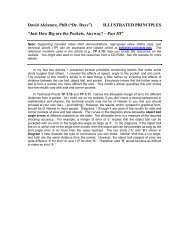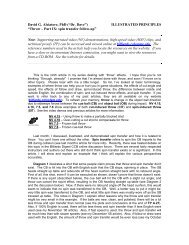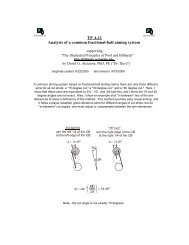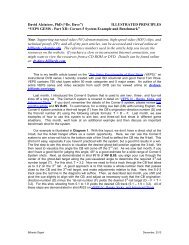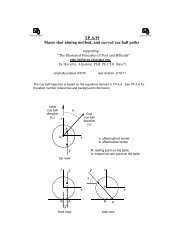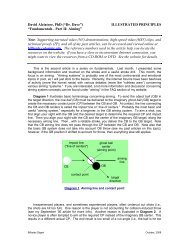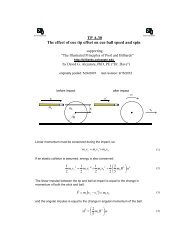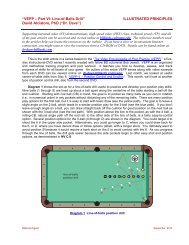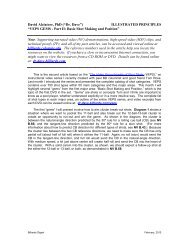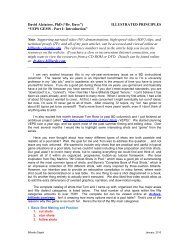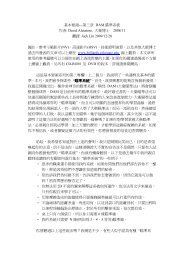VEPP – Part XIV: Custom Drills - Illustrated Principles of Pool and ...
VEPP – Part XIV: Custom Drills - Illustrated Principles of Pool and ...
VEPP – Part XIV: Custom Drills - Illustrated Principles of Pool and ...
Create successful ePaper yourself
Turn your PDF publications into a flip-book with our unique Google optimized e-Paper software.
After practicing <strong>and</strong> succeeding with the first shot in Diagram 1 several times, progressively advance the<br />
target ball up table to develop a feel for how you need to adjust speed <strong>and</strong> spin to send the CB along each <strong>of</strong><br />
the desired lines. For target position “B,” you can still use a rolling CB, but you need to add more sidespin.<br />
The amount <strong>of</strong> sidespin required will vary some with table conditions. The CB direction will also vary a little<br />
depending on how much you might cheat the pocket, which changes the cut angle slightly. Sidespin makes<br />
the shot more difficult because you need to be able to adjust for the squirt <strong>and</strong> swerve that comes with using<br />
english. For information <strong>and</strong> demonstrations for how to compensate for squirt <strong>and</strong> swerve, see the “aim<br />
compensation” FAQ page on my website. For target position “C,” Bob used nearly maximum english, still<br />
allowing the CB to roll. For target position “D,” Bob used near maximum sidespin with slight draw to create<br />
drag which increases the effect <strong>of</strong> the sidespin. See how high you can send the CB up table using draw,<br />
sidespin, <strong>and</strong>/or pocket cheating. The side pocket was close to the limit on my table.<br />
Diagram 2 shows another example custom progressive drill that focusses on a common “problem shot”<br />
for many people. The goal is to pocket the 2-ball <strong>and</strong> send the CB directly across the table a controlled<br />
amount. We have a printable target available on the <strong>VEPP</strong> website that you can cut out to serve as the CB<br />
goal position. Start with the target one diamond <strong>of</strong>f the long rail, <strong>and</strong> progressively move it farther away with<br />
each success. The CB is always shot from the same spot, across from the side pocket a diamond <strong>of</strong>f the rail.<br />
We have a demonstration <strong>of</strong> the drill in NV C.20. Because there is a slight cut angle on this shot, a stun shot<br />
would send the CB along the tangent line, which would send the CB a little up table. One approach to having<br />
the CB head straight across table instead is to make sure the CB has a slight amount <strong>of</strong> forward roll when it<br />
reaches the object ball. In the video, for the starting target position, Bob uses a center-ball hit at medium<br />
speed to accomplish the task. The CB picks up a little forward roll by itself on the way to the 2-ball.<br />
Diagram 2 <strong>Custom</strong> stun-across-the-table drill<br />
As you add more speed to send the CB to the more-distant target positions, you will need to raise the tip<br />
a little to allow the CB to develop slight forward roll. As we demonstrate in NV C.20, as long as you end up<br />
within a h<strong>and</strong> span <strong>of</strong> the target, call it good. This drill is challenging because you need to be accurate with<br />
the exact cut angle <strong>of</strong> the shot (i.e., you can’t cheat the pocket too much), the amount <strong>of</strong> CB forward roll at<br />
impact needs to be fairly precise, <strong>and</strong> the speed needs to be good to reach the target distance. Try out the<br />
drill <strong>and</strong> practice sending the CB to each <strong>of</strong> the target positions shown in the diagram. Even with the<br />
relatively small cut angle <strong>of</strong> the shot, it is still easy to get the CB across the entire table width. The key is to<br />
be accurate <strong>and</strong> consistent at the different distances so you will be able to control the CB when needed in a<br />
game situation.<br />
Billiards Digest May, 2013



